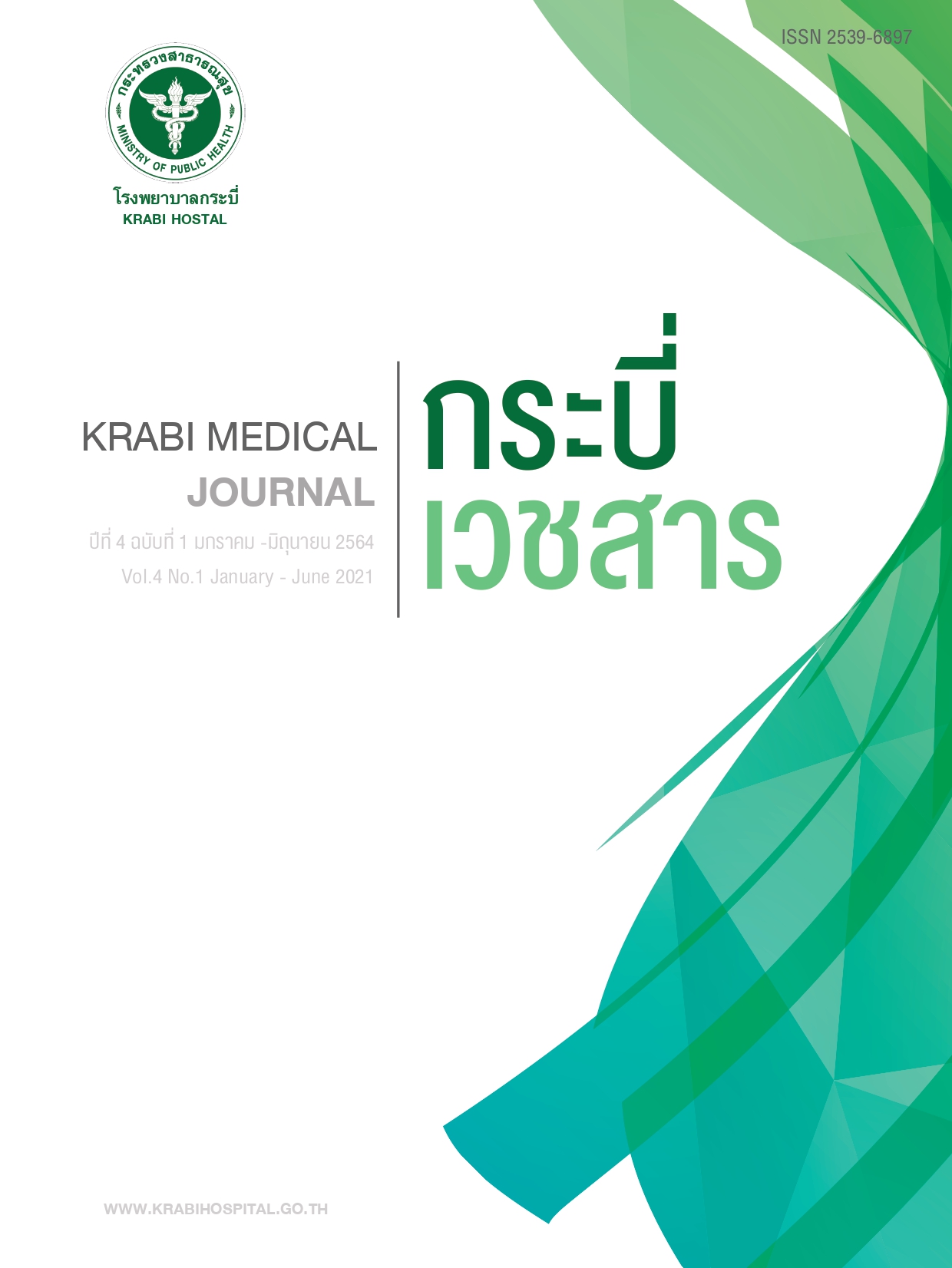The Development of Clinical Nursing Practice Guideline for Prevent Venous Thromboembolism (VTE) in Orthopedic Patients
Main Article Content
Abstract
This research and development is aimed at the development of clinical nursing practice guideline for preventing Venous Thromboembolism (VTE) in orthopedic patients under the conceptual framework of Deming Cycle (PDCA) for continuous quality improvement which include 4 stages: Plan, Do, Check and Act. The 2 sample groups are 25 clinical nursing practitioners and 52 orthopedic patients. The research tools include clinical nursing practice guideline for preventing Venous Thromboembolism, survey of practitioners’ opinion on practicality of the guideline, evaluation of compliance to clinical nursing practice, nursing care key performance indicators (KPI) report, survey of nurses on their satisfaction with the use of the guideline, orthopedic patients’ satisfaction survey on nursing services. All research tools passed the test of validity consistency index and reliability assessed by using Cronbach’s Alpha Coefficient. The data analysis was conducted using percentile, mean and standard deviation and 3 groups of patients were compared by using analysis of Variation (ANOVA).
The findings of the research show: 1. The Clinical Nursing Practice Guideline for Preventing VTE in Orthopedic Patients includes VTE Risk Evaluation and Screening form of Krabi Hospital’s orthopedic patients (Modified: Autar VTE Risk Assessment Scale, 2003) and nursing care practices for preventing VTE of Krabi Hospital’s orthopedic patients by considering risk score of the patients. 2. The results of using the Clinical Nursing Practice Guideline, process results are 1) Participated nurses rated the practicality of this guideline at high. Effectiveness of the practice guideline is the most feasible ( =4.12, SD=0.60) while the least feasible is its economizing ( =3.80, SD=0.71). The nurses did not perform all the nursing practices in accordance with the risk scores. 92% gave information to the patients and their relatives on the necessity of VTE prevention and 92% encouraged early ambulation patients to have at least 2,000 cc. water/ fluids intake per day. 84% performed patient reassessment while 32% consulted attending physicians on giving the patients anticoagulant drugs which was the least performed practice. The participated nurses rated their satisfaction with the guideline at highest ( =4.63, SD=0.57). 2) All 52 orthopedic patients were evaluated and screened for risk of VTE. They were separated into 3 groups: 5.77% were low risk, 42.31% were medium risk and 38.46% were high risk. The satisfaction with the overall nursing care services was rated high by low-risk group ( =4.00, SD=1.00), by medium-risk group ( =3.86, SD=0.64) and also by high-risk group ( =3.93, SD=0.47). The incidents of VTE were found in 5 orthopedic patients in high-risk group equaling to 9.6% of the participated patients, however, none were found in those in low- or medium-risk groups. There was no incident of death from VTE in every group of patients.
In conclusion, the Clinical Nursing Practice Guideline for Preventing VTE in Orthopedic Patients can be used as nursing practice guideline throughout the organization resulting in how patients receive standard nursing care and know treatment process and in reducing, preventing or giving proper nursing care in case of any complication. These all lead to patients’ safety and satisfaction with nursing service.
Article Details

This work is licensed under a Creative Commons Attribution-NonCommercial-NoDerivatives 4.0 International License.
บทความนิพนธ์ต้นฉบับจะต้องผ่านการพิจารณาโดยผู้ทรงคุณวุฒิที่เชี่ยวชาญอย่างน้อย 2 ท่าน แบบผู้ทรงคุณวุฒิ และผู้แต่งไม่ทราบชื่อกันและกัน (double-blind review) และการตีพิมพ์บทความซ้ำต้องได้รับการอนุญาตจากกองบรรณาธิการเป็นลายลักษณ์อักษร
ลิขสิทธิ์
ห้ามนำข้อความทั้งหมดหรือบางส่วนไปพิมพ์ เว้นว่าได้รับอนุญาตจากโรงพยาบาลเป็นลายลักษณ์อักษร
ความรับผิดชอบ
เนื้อหาต้นฉบับที่ปรากฏในวารสารเป็นความรับผิดชอบของผู้เขียน ทั้งนี้ไม่รวมความผิดพลาดอันเกิดจากเทคนิคการพิมพ์
References
ศิวดล วงค์ศักดิ์ และคณะ. การศึกษาอัตราการเกิดภาวะเส้นเลือดดำอุดตันที่ขาก่อนผ่าตัดในผู้ป่วยที่เข้ารับการเปลี่ยนข้อสะโพกและข้อเข่าเทียมที่มีความเสี่ยงสูง. Rama Med J 2017; 40: 1-7
วิระพล ภิมาลย์. บทความวิชาการ ยาที่ใช้ในการรักษาภาวะลิ่มเลือดอุดตันที่หลอดเลือดดำ. สภา
เภสัชกรรม. 2560.
Chotanaphuti T, Ongnamthip P, Silpipat S, Foojareonyos T, Roschan S, Reumthantong A. Enoxaparin versus No Anticoagulation Prophylaxis after Total Knee Arthroplasty in Thai Patients: A Randomized Controlled Trial. J Med Assoc Thai 2017;100.
บูรพา ปุสธรรม. บทฟื้นฟูวิชาการ Review Article :โรคลิ่มเลือดอุดกั้นในหลอดเลือดปอด
เฉียบพลัน. ศรีนครินทร์เวชสาร ปี 2557; 29:485-496.
Susan R. Kahn. How I treat post thrombotic syndrome. 2009 [2020 March]; Available
from https://ashpublications.org/blood
เกสร พรมเหล็ก. การพัฒนาและประเมินผลการใช้แนวปฏิบัติการพยาบาล เพื่อป้องกันการเกิด
ภาวะลิ่มเลือดอุดกั้นหลอดเลือดดำ ในผู้ป่วยวิกฤตอุบัติเหตุ (วิทยานิพนธ์ปริญญาพยาบาล
มหาบัณฑิต). บัณฑิตวิทยาลัย. มหาวิทยาลัยสงขลานครินทร์; 2553.
พัชรินทร์ สุตันตปฤดา และมัชฌิมา กิติศรี. การพัฒนาแนวปฏิบัติการพยาบาลทางคลินิกเพื่อ
ป้องกันภาวะลิ่มเลือดอุดตันหลอดเลือดดำ สำหรับผู้ป่วยศัลยกรรมออร์โธปิดิกส์ โรงพยาบาล
นครพิงค์. วารสารโรงพยาบาลนครพิงค์ ปี 2558;6:29-37.
สถาบันรับรองคุณภาพสถานพยาบาล (องค์การมหาชน). เป้าหมายความปลอดภัยของผู้ป่วยของ
ประเทศไทย พ.ศ.2561. พิมพ์ครั้งที่ 2. กรุงเทพมหานคร: เฟมัส แอนด์ ซัคเซ็สฟูล; 2561.
Autar R. The management of deep vein thrombosis: the Autar DVT risk assessment
scale re-visited. Journal of Orthopaedic Nursing 2003;7:114–124
D Lillis, C Lloyd, P O’Kelly, S Kelada, S Kelly, P Gilligan. DVT Presentations to an
Emergency Department: A Study of Guideline Based Care and Decision Making. 2016
April 20202]; Available from https://www.lenus.ie
Bergmann JF, Kher A. Venous thromboembolism in medically ill patient: A call to
action. Blackwell Publishing; 2005.
จุมพล วิลาศรัศมี. โรคหลอดเลือดดำ. กรุงเทพมหานคร: สำนักพิมพ์กรุงเทพเวชสาร; 2550.
สินธิป พัฒนะคูหา, ปรัชญพร คำเมืองลือ, สยาม ทองประเสริฐ, อภิชนา โฆวินทะ และ อดิศักดิ์
ตันติวรวิทย์. การป้องกันภาวะลิ่มเลือดอุดหลอดเลือดดำสำหรับผู้ป่วยบาดเจ็บไขสันหลัง กลุ่มวิจัย
บาดเจ็บไขสันหลัง. J Thai Rehabil Med 2018; 28(1).
ยิ่งยง ชินธรรมมิตร์. บทความฟื้นวิชา การหาสาเหตุของภาวะลิ่มเลือดอุดตันหลอดเลือดใน
ผู้ใหญ่. วารสารโลหิตวิทยา และเวชศาสตร์บริการโลหิต ปี 2560;27.
พรทิพย์ สารีโส และ เกศรินทร์ อุทริยะประสิทธ์. การประยุกต์ใช้หลักฐานเชิงประจักษ์เพื่อ
ป้องกันหลอดเลือดดำอุดกั้นในผู้ป่วยอายุรกรรม-ศัลยกรรม ภาควิชาการพยาบาลอายุรศาสตร์
มหาวิทยาลัยมหิดล; J Nurs Sci 2011;29(2):27-36
สถาบันเพิ่มผลผลิตแห่งชาติ. PDCA หัวใจสำคัญของการปรับปรุงอย่างต่อเนื่อง. [23 เมษายน
; เข้าถึงได้จาก http://www.ftpi.or.th
ประกาย จิโรจน์กุล. การวิจัยทางการพยาบาล: แนวคิด หลักการ และวิธีปฏิบัติ. พิมพ์ครั้งที่ 3.
นนทบุรี: โครงการสวัสดิการวิชาการ สถาบันพระบรมราชชนก ; 2556.


